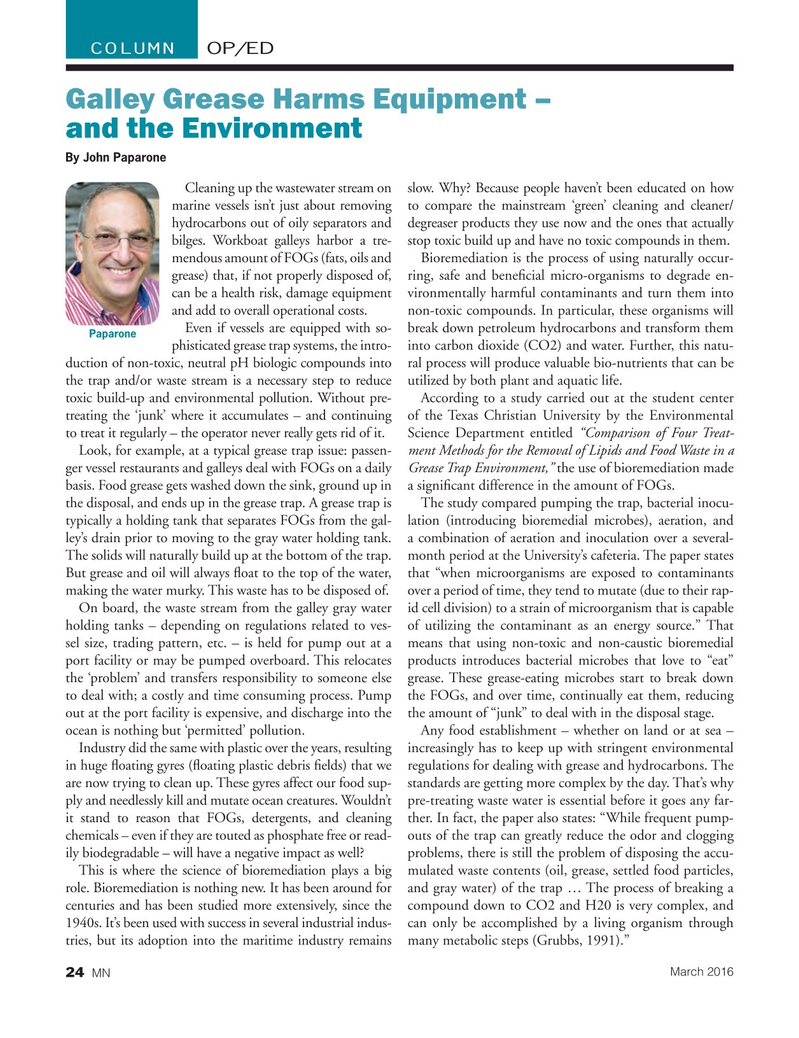
Page 24: of Marine News Magazine (March 2016)
Push boats, Tugs & Assist Vessels
Read this page in Pdf, Flash or Html5 edition of March 2016 Marine News Magazine
COLUMN OP/ED
Galley Grease Harms Equipment – and the Environment
By John Paparone
Cleaning up the wastewater stream on slow. Why? Because people haven’t been educated on how marine vessels isn’t just about removing to compare the mainstream ‘green’ cleaning and cleaner/ hydrocarbons out of oily separators and degreaser products they use now and the ones that actually bilges. Workboat galleys harbor a tre- stop toxic build up and have no toxic compounds in them.
mendous amount of FOGs (fats, oils and Bioremediation is the process of using naturally occur- grease) that, if not properly disposed of, ring, safe and bene? cial micro-organisms to degrade en- can be a health risk, damage equipment vironmentally harmful contaminants and turn them into and add to overall operational costs. non-toxic compounds. In particular, these organisms will
Even if vessels are equipped with so- break down petroleum hydrocarbons and transform them
Paparone phisticated grease trap systems, the intro- into carbon dioxide (CO2) and water. Further, this natu- duction of non-toxic, neutral pH biologic compounds into ral process will produce valuable bio-nutrients that can be the trap and/or waste stream is a necessary step to reduce utilized by both plant and aquatic life.
toxic build-up and environmental pollution. Without pre- According to a study carried out at the student center treating the ‘junk’ where it accumulates – and continuing of the Texas Christian University by the Environmental to treat it regularly – the operator never really gets rid of it. Science Department entitled “Comparison of Four Treat-
Look, for example, at a typical grease trap issue: passen- ment Methods for the Removal of Lipids and Food Waste in a ger vessel restaurants and galleys deal with FOGs on a daily Grease Trap Environment,” the use of bioremediation made basis. Food grease gets washed down the sink, ground up in a signi? cant difference in the amount of FOGs.
the disposal, and ends up in the grease trap. A grease trap is The study compared pumping the trap, bacterial inocu- typically a holding tank that separates FOGs from the gal- lation (introducing bioremedial microbes), aeration, and ley’s drain prior to moving to the gray water holding tank. a combination of aeration and inoculation over a several-
The solids will naturally build up at the bottom of the trap. month period at the University’s cafeteria. The paper states
But grease and oil will always ? oat to the top of the water, that “when microorganisms are exposed to contaminants making the water murky. This waste has to be disposed of. over a period of time, they tend to mutate (due to their rap-
On board, the waste stream from the galley gray water id cell division) to a strain of microorganism that is capable holding tanks – depending on regulations related to ves- of utilizing the contaminant as an energy source.” That sel size, trading pattern, etc. – is held for pump out at a means that using non-toxic and non-caustic bioremedial port facility or may be pumped overboard. This relocates products introduces bacterial microbes that love to “eat” the ‘problem’ and transfers responsibility to someone else grease. These grease-eating microbes start to break down to deal with; a costly and time consuming process. Pump the FOGs, and over time, continually eat them, reducing out at the port facility is expensive, and discharge into the the amount of “junk” to deal with in the disposal stage.
ocean is nothing but ‘permitted’ pollution. Any food establishment – whether on land or at sea –
Industry did the same with plastic over the years, resulting increasingly has to keep up with stringent environmental in huge ? oating gyres (? oating plastic debris ? elds) that we regulations for dealing with grease and hydrocarbons. The are now trying to clean up. These gyres affect our food sup- standards are getting more complex by the day. That’s why ply and needlessly kill and mutate ocean creatures. Wouldn’t pre-treating waste water is essential before it goes any far- it stand to reason that FOGs, detergents, and cleaning ther. In fact, the paper also states: “While frequent pump- chemicals – even if they are touted as phosphate free or read- outs of the trap can greatly reduce the odor and clogging ily biodegradable – will have a negative impact as well? problems, there is still the problem of disposing the accu-
This is where the science of bioremediation plays a big mulated waste contents (oil, grease, settled food particles, role. Bioremediation is nothing new. It has been around for and gray water) of the trap … The process of breaking a centuries and has been studied more extensively, since the compound down to CO2 and H20 is very complex, and 1940s. It’s been used with success in several industrial indus- can only be accomplished by a living organism through tries, but its adoption into the maritime industry remains many metabolic steps (Grubbs, 1991).”
March 2016
MN 24
MN Mar16 Layout 18-31.indd 24 2/19/2016 10:51:27 AM

 23
23

 25
25
